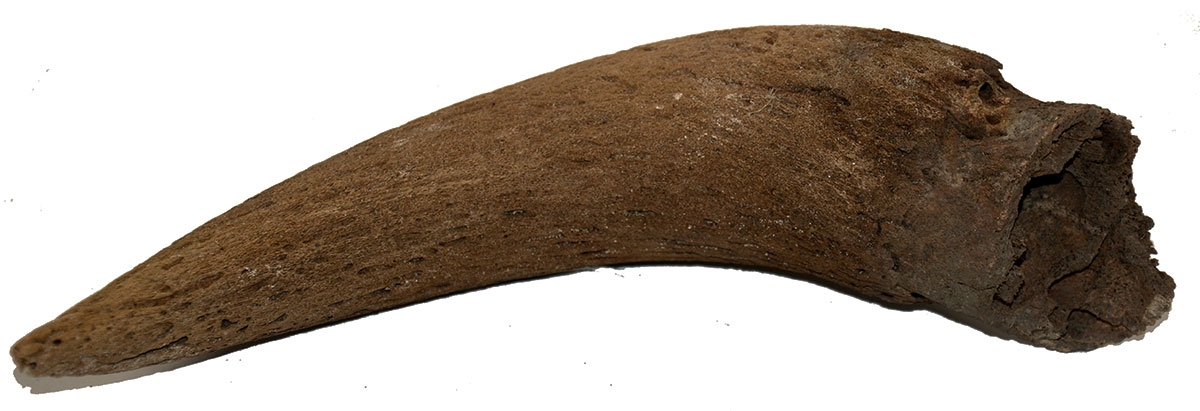site search
online catalog
A POWDER HORN IN THE MAKING FROM FORT PEMBINA

$65.00 SOLD
Quantity Available: None
Item Code: 1052-458
Soldiers in remote US army frontier forts likely spent a lot more time fighting boredom in garrison than they did fending off attacks or campaigning. In this case it looks very much like a soldier posted to Fort Pembina, North Dakota, decided to try his hand at making an old-fashioned powder horn, or simply carving one as a memento. This horn measures about 9” inches long and shows some effort at smoothing and rounding on one end, but the soldier seems to have given it up fairly quickly, in favor of some other wholesome pursuit to while away the time, like fishing or poker.
Fort Pembina, situated in the Red River Valley in North Dakota near the Canadian border, was established in 1870 and in operation until 1895. Trading posts existed earlier in the area as part of the fur trade, and the first U.S. military post there was temporary- manned by a detachment of Minnesota troops in 1863-1864 following the 1862 Sioux uprising. In March 1870 a new fort was established south of the Pembina River and about 200 yards west of the Red River, completed by July and named in honor of Gen. George H. Thomas. The name was changed to Fort Pembina in September and the initial garrison consisted of two companies of the 20th US Infantry. Their main purpose was to provide security for settlers worried about Sioux returning south from Canada, but the troops spent much of their time escorting boundary surveys along the Canadian border and preventing Fenian raids heading north into Canada.
The fort included enlistedmen’s barracks, officers’ quarters, guard house, ordnance storehouse, company kitchen, root house, laundress’s quarters, quarters for civilian employees, hospital and hospital servant’s house, a barn for the “hospital cow,” quartermaster and commissary offices and storehouse, stables, wagon shed, etc. The garrison reached peak strength in 1878 af 200, but the average was about 125 enlisted men and 8 officers. An October 1885 return listed 97 men, 2 field pieces, 1 mountain howitzer, 100 rifles, 19 pistols, 23 mules, and 9 wagons. By 1890 the post had just 23 men, and after an 1895 fire destroyed some 19 buildings it was decided to abandon the fort rather than rebuild, the last detachment left in September. The property was turned over to the Interior Department and later sold in 1902.
The surface is a light brown in color, with a jagged broad end that shows some effort at smoothing the surface, but the maker did not get far along. He did not make an effort to clear out the horn’s interior, or found that part of the effort too difficult. It comes from excavations in wet, anaerobic soil that has preserved all sorts of relics from daily life at the fort that would not normally be preserved and offer some interesting insights into the material culture of a remote army post. [sr][ph:L]
~~~~~~~~~~~~~~~~~~~~~~~~~~~~~~~~~~~
THIS ITEM, AS WITH ALL OTHER ITEMS AVAILABLE ON OUR WEB SITE,
MAY BE PURCHASED THROUGH OUR LAYAWAY PROGRAM.
CLICK HERE FOR OUR POLICIES AND TERMS.
THANK YOU!
Inquire About A POWDER HORN IN THE MAKING FROM FORT PEMBINA
For inquiries, please email us at [email protected]
Most Popular
Historical Firearms Stolen From The National Civil War Museum In Harrisburg, Pa »
Theft From Gravesite Of Gen. John Reynolds »
Selection Of Unframed Prints By Don Troiani »
Fine Condition Brass Infantry Bugle Insignia »
Wonderful Condition Original Confederate-Manufactured Kepi For A Drummer Boy Or Child »
featured item
CDV OF 2ND LIEUTENANT CHARLES E. CROW, 4TH VA. (PURCELL) LIGHT ARTILLERY
This is a very nice CDV photograph of Charles E. Crow in Confederate uniform. It appears to be a second-generation image; photo of an existing photo. Regardless, the picture is clear with good contrast. Crow wears a Confederate 2nd lieutenant's,… (1138-988). Learn More »
site search
Upcoming Events
The shop is closed Jan. 2nd thru Jan. 16th for inventory; we will still be available by phone &… Learn More »





